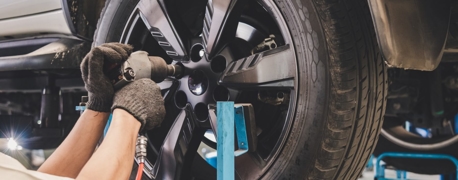10 Safety Reminders for Warm Weather Driving

Winter may get a lot of attention for hazardous driving conditions – and for good reason – but spring is also a season that has a number of dangers to consider. We’ve compiled some of the greatest risks presented by warm spring weather and the steps you can take to stay safe on the road.
Whether you drive a commercial truck for a living, deliver goods or food throughout your community, or drive your kids to school and yourself to work, the following reminders can help you get there safely.
1. Watch for Unpredictable Spring Weather!
Although spring may bring thoughts of sunshine, flowers, and warm temperatures, in many parts of the country, the season is known for its unpredictable and often extreme weather. Spring can bring heavy rains, thunderstorms, sleet and snow, strong winds, and even tornadoes in some areas. Always check the weather before you hit the road so you know what to expect. If severe weather is expected, it might be a good idea to avoid driving altogether.
2. Be Careful of Wet Roads & Flooding
Melting snow and spring showers can cause wet roads, flooding, and landslides. Flash floods are particularly serious, as they can wash out roads and carry vehicles away. They can happen in virtually any area that has been hit with heavy rain, including urban areas, suburban communities, and the countryside. In addition to watching for (and listening to) flash flood warnings in your area, be sure to take extra caution when driving on wet, slick roads.
Here are a few quick safety tips for driving on wet roads:
- Slow down, adjusting your speed to accommodate the loss of traction.
- Check your tires! Make sure they’re inflated properly and have enough tread (no less than 2/32 of an inch.)
- Try to avoid large puddles and flooded roads. These can be deeper than you think and can cause hydroplaning.
- Watch for potholes. These can cause flat tires and can even make you lose control of your vehicle.
- Don’t use cruise control. Keep in physical control of your vehicle at all times.
- Try to avoid sudden movements, which can cause loss of traction and control.
If you find that you suddenly lose traction on a wet road, don’t slam on the brakes or swerve. Try to gently steer in the direction your car is traveling, which can help realign your tires with the road. Take your foot off the accelerator and wait until you feel your tires reconnect. At that point, you can safely pull over to the side of the road or continue driving, depending on the situation and how you feel.
3. Schedule Your Vehicle Maintenance
Keeping your vehicle properly maintained is extremely important any time the seasons change. This includes everything from checking your tire pressure (which can change with sudden temperature drops or increases!) to your windshield wipers. Tire tread is another important issue to keep an eye on, as you’ll need all the traction you can get on wet roads. Clean your backup cameras and car sensors, and schedule your vehicle maintenance if it’s due. Having a professional check out every part of your car or truck can bring peace of mind knowing you’re ready for unpredictable weather and increased traffic.
4. Watch for Road Construction
Warmer spring temperatures typically mean that road construction projects can resume or begin. Be sure to watch for detours, construction vehicles, work crews, barriers, barrels, and potholes. Reduce your speed in construction zones and follow the signs and instructions of road construction crews to reduce your likelihood not only of an accident but of damaging your vehicle by driving where you shouldn’t.
5. Get Ready for More Pedestrians, Cyclists & Traffic
With warmer weather, you can expect to see more pedestrians, cyclists, and traffic on the roads in your area. Especially if it snows where you live, people will be ready to get outdoors and enjoy the warm weather and sunshine whenever they can. So, keep a lookout not only for more cars on the road but for more people walking and riding around your city or town. Observe traffic laws regarding pedestrians, cyclists, and their right of way.
6. Does Your Allergy Medicine Have Side Effects?
As many as 60 million Americans are affected by pollen and allergies each year, according to the Centers for Disease Control and Prevention (CDC). If the warmer spring weather causes your allergies to kick into full gear, be sure to check your allergy medication for potential side effects. Over-the-counter and prescription medicines can have side effects that could affect your ability to drive safely, like drowsiness. Check the label before you get behind the wheel.
7. Be Careful of the Time Change
The “Spring forward” time change is more than an inconvenience. According to a study published in Current Biology, fatal traffic accidents increase by 6% in the week following the Daylight Saving Time change every spring. This is particularly true in the morning. In addition to feeling more tired from essentially “losing an hour,” the spring time change alters visibility. The drive you were used to taking every morning or evening may look much different after you change your clocks forward an hour. Try to make sure you give yourself enough time to sleep and be extra cautious on the roads after the Daylight Saving Time change.
8. Watch for Animals
As the weather warms up, you can expect to see more animals – and they can sometimes make their way onto roads and highways. Most animals will be more active in warmer weather, especially in the early morning and at dusk. Stay alert and reduce your speed in areas where animals are usually present.
If you do hit an animal while driving:
- Pull over to the side of the road when it’s safe to do so.
- Call the police to report the incident (this might be required by law, depending on the type of animal you hit).
- Take care approaching the animal. You should not approach a bear, mountain lion, or other predator, and you should take caution approaching any large animal, like a deer or moose. Even smaller animals and family pets can lash out if injured. Be cautious and, if you believe you may be in danger, remain in your vehicle until authorities arrive.
- Contact the animal’s owner, if applicable.
- Call a local vet or shelter to care for the injured animal.
- Take photos of your car and the scene.
- If you were injured, seek medical attention. Hitting a large animal can cause damage to your vehicle and it may cause injuries like whiplash.
- Contact your insurance company to report the accident.
9. Help Your Teen Practice Safe Driving
With warm spring weather, spring break, and even while school is in session, it’s a good time to brush up on safe driving practices with your teen driver. For insight on this tricky topic, check out our blog: 6 Ways to Encourage Your Teen to Practice Safe Driving.
10. If You Work Outdoors, Don’t Forget These Warm Weather Hazards
Whether you’re a construction worker high on scaffolding, a flagman helping to direct traffic in a road construction zone, or a power lineman, you face certain risks in the warmer spring weather. Not only can rain, thunderstorms, and lightning make your work dangerous, you could begin to face risks like heat exhaustion as the weather warms up. Make sure your employer is doing their part to keep your worksite safe and free from undue hazards. For more information on this subject, see our blog: Spring Showers Bring 11 Safety Concerns & Risks.
Helping Drivers & Passengers Nationwide
Car accidents, truck accidents, motorcycle accidents, and other traffic collisions happen in the blink of an eye. We try to do what we can to avoid them, but sometimes another person makes a decision that changes everything. Sometimes companies make unsafe products or fail to train their drivers. When bad choices and a profits-first mentality cause crashes that injure innocent people and claim lives, our attorneys stand up for the injured and their families.
At Arnold & Itkin, we believe in helping people recover after the worst accidents and losses. We find answers and help them get the care and support they need to rebuild. If you want to learn more about what you can do after a motor vehicle accident, give us a call at (888) 493-1629. We’re standing by to help.
- Categories


